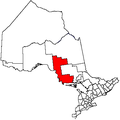Thessalon | |
|---|---|
| Town of Thessalon | |
 Thessalon waterfront | |
| Coordinates: 46°15′23″N83°33′26″W / 46.25639°N 83.55722°W | |
| Country | Canada |
| Province | Ontario |
| District | Algoma |
| Government | |
| • Type | Town |
| • Mayor | Jordan Bird |
| • MP | Terry Sheehan (Liberal) |
| • MPP | Bill Rosenberg (PC) |
| Area | |
| • Land | 4.38 km2 (1.69 sq mi) |
| Population (2021) [1] | |
• Total | 1,260 |
| • Density | 287.5/km2 (745/sq mi) |
| Time zone | UTC−05:00 (EST) |
| • Summer (DST) | UTC−04:00 (EDT) |
| Postal code | P0R 1L0 |
| Area code(s) | 705 |
| Website | www |
Thessalon is a town in the Canadian province of Ontario, located at the junction of Highway 17 and Highway 129 on the north shore of Lake Huron. It is surrounded by, but not part of, the municipality of Huron Shores, and is part of Algoma District. The main industries are timber and tourism. The town is a popular retirement community. It is the administrative headquarters of the Thessalon First Nation, Algoma Mutual Insurance, and the Algoma District Services Administration Board as District Seat.



